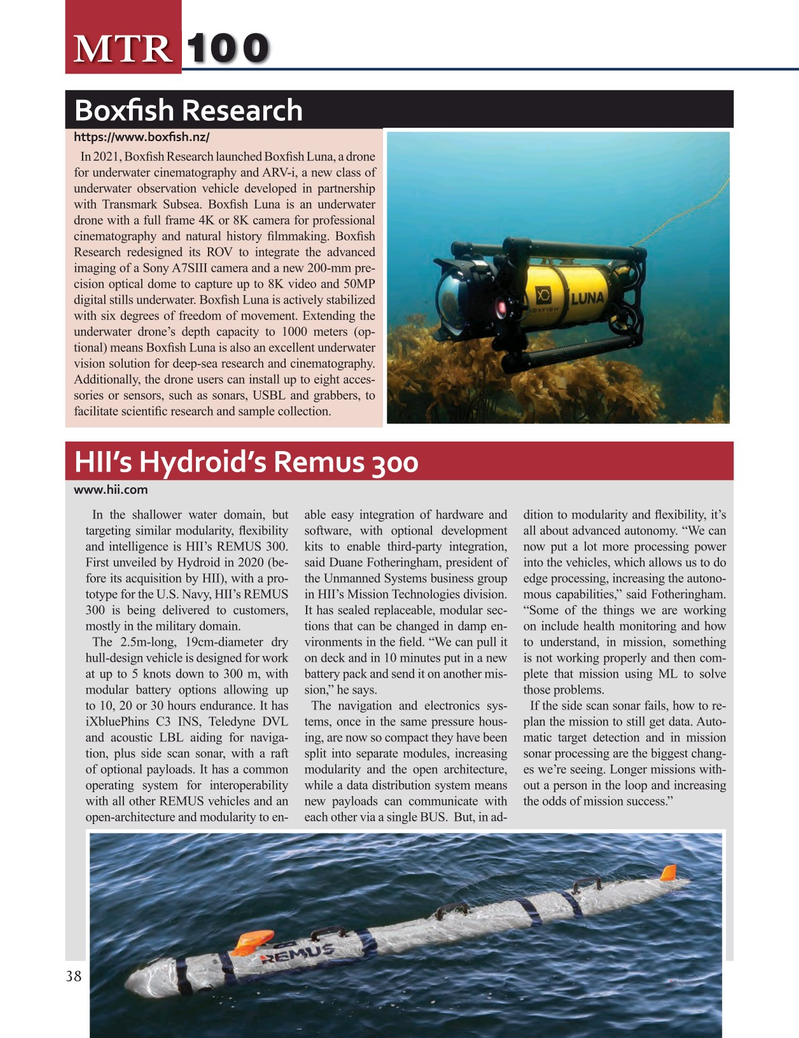
Page 38: of Marine Technology Magazine (September 2022)
Read this page in Pdf, Flash or Html5 edition of September 2022 Marine Technology Magazine
MTR 100
Box? sh Research https://www.box? sh.nz/
In 2021, Box? sh Research launched Box? sh Luna, a drone for underwater cinematography and ARV-i, a new class of underwater observation vehicle developed in partnership with Transmark Subsea. Box? sh Luna is an underwater drone with a full frame 4K or 8K camera for professional cinematography and natural history ? lmmaking. Box? sh
Research redesigned its ROV to integrate the advanced imaging of a Sony A7SIII camera and a new 200-mm pre- cision optical dome to capture up to 8K video and 50MP digital stills underwater. Box? sh Luna is actively stabilized with six degrees of freedom of movement. Extending the underwater drone’s depth capacity to 1000 meters (op- tional) means Box? sh Luna is also an excellent underwater vision solution for deep-sea research and cinematography.
Additionally, the drone users can install up to eight acces- sories or sensors, such as sonars, USBL and grabbers, to facilitate scienti? c research and sample collection.
HII’s Hydroid’s Remus 300 www.hii.com
In the shallower water domain, but able easy integration of hardware and dition to modularity and ? exibility, it’s targeting similar modularity, ? exibility software, with optional development all about advanced autonomy. “We can and intelligence is HII’s REMUS 300. kits to enable third-party integration, now put a lot more processing power
First unveiled by Hydroid in 2020 (be- said Duane Fotheringham, president of into the vehicles, which allows us to do fore its acquisition by HII), with a pro- the Unmanned Systems business group edge processing, increasing the autono- totype for the U.S. Navy, HII’s REMUS in HII’s Mission Technologies division. mous capabilities,” said Fotheringham. 300 is being delivered to customers, It has sealed replaceable, modular sec- “Some of the things we are working mostly in the military domain. tions that can be changed in damp en- on include health monitoring and how
The 2.5m-long, 19cm-diameter dry vironments in the ? eld. “We can pull it to understand, in mission, something hull-design vehicle is designed for work on deck and in 10 minutes put in a new is not working properly and then com- at up to 5 knots down to 300 m, with battery pack and send it on another mis- plete that mission using ML to solve modular battery options allowing up sion,” he says. those problems. to 10, 20 or 30 hours endurance. It has The navigation and electronics sys- If the side scan sonar fails, how to re- iXbluePhins C3 INS, Teledyne DVL tems, once in the same pressure hous- plan the mission to still get data. Auto- and acoustic LBL aiding for naviga- ing, are now so compact they have been matic target detection and in mission tion, plus side scan sonar, with a raft split into separate modules, increasing sonar processing are the biggest chang- of optional payloads. It has a common modularity and the open architecture, es we’re seeing. Longer missions with- operating system for interoperability while a data distribution system means out a person in the loop and increasing with all other REMUS vehicles and an new payloads can communicate with the odds of mission success.” open-architecture and modularity to en- each other via a single BUS. But, in ad- 38
MTR #7 (34-49).indd 38 10/3/2022 12:53:36 PM

 37
37

 39
39
